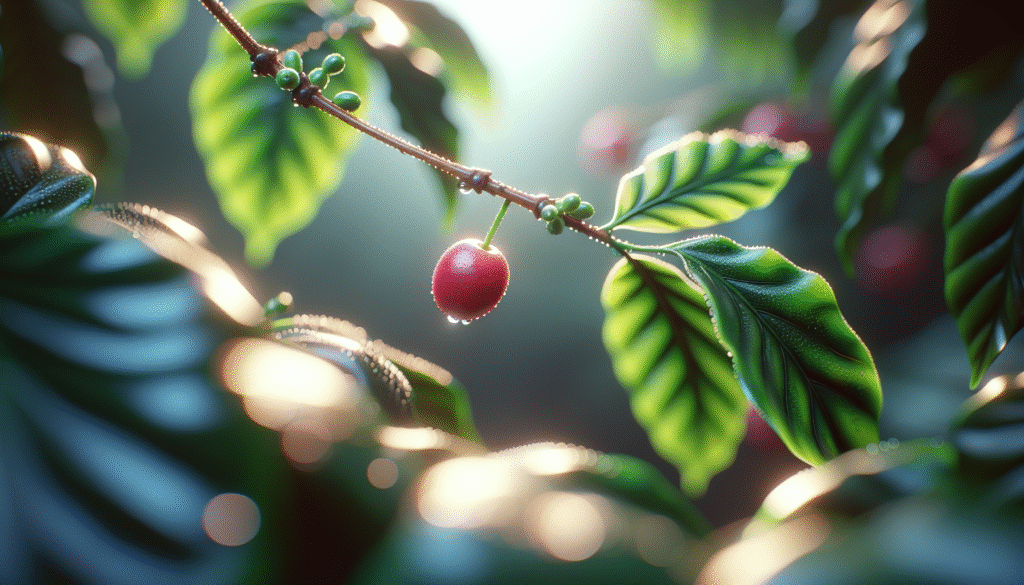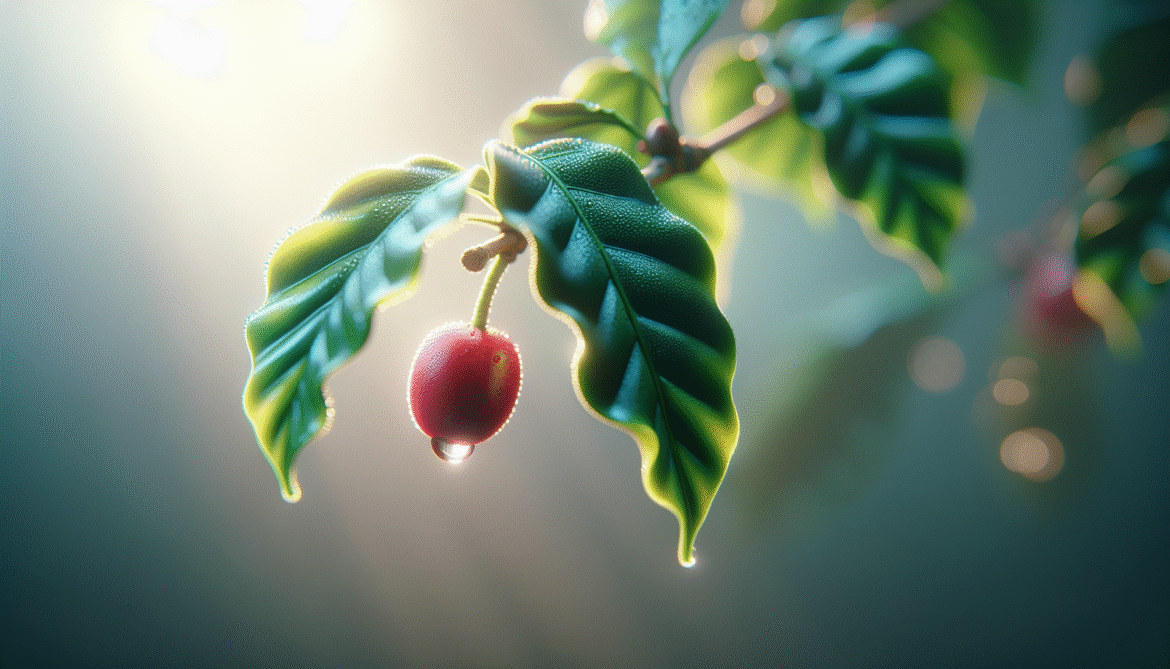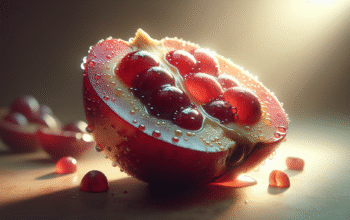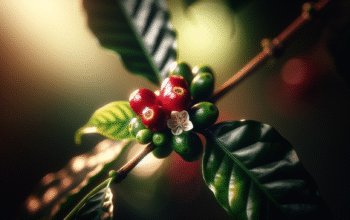Have you ever wondered whether the coffee beans you grind and brew actually grow on trees?

Do Coffee Beans Grow on Trees
You might be surprised to learn that what we call “coffee beans” are not beans in the everyday sense, and they do grow on woody plants that can reach tree size. The story of how those seeds become the coffee you drink involves fruit, flowers, careful cultivation, harvesting, and processing.
What is a coffee bean?
You need to know that a coffee bean is actually the seed of a fruit commonly called a coffee cherry. Inside each ripe cherry are usually one or two seeds; those seeds are what we call coffee beans after processing and roasting.
The name “bean” stuck because the seeds resemble true beans in shape, but botanically they’re seeds. Once you understand that a coffee bean begins its life inside a fruit on a plant, much of the rest of the coffee lifecycle becomes easier to follow.
Coffee cherries and anatomy
When you look at a coffee cherry, you’re seeing several layers that protect the seeds inside. You’ll notice an outer skin, a fleshy pulp, mucilage, a parchment layer, a thin silver skin, and finally the seed.
These layers matter because different processing methods remove these layers in different ways, affecting flavor and quality. For example, washed (wet-processed) coffees remove pulp and mucilage early, while natural (dry-processed) coffees dry the whole cherry with the seed inside, creating different taste profiles.
Do coffee plants grow on trees or shrubs?
You’ll hear coffee plants described as shrubs or small trees, and both descriptions are correct depending on how they’re grown. In the wild or when left unpruned, coffee plants of species like Coffea arabica can grow into small trees up to 10 meters tall. On farms, growers usually prune coffee to a manageable bush form of 1.5–3 meters for easier harvesting.
Pruning and tending influence yield, plant health, and ease of harvest. When a farmer prunes regularly and shapes plants into lower bushes, the plants behave more like multi-stemmed shrubs, but the underlying plant is tree-like in structure.
Lifespan and maturity
You can expect a coffee plant to start bearing fruit a few years after planting, usually 2–4 years depending on the species and growing conditions. Peak production often occurs between years 5 and 20, although plants can produce for decades with good care.
Your coffee tree’s productive lifespan depends on variety, climate, disease pressure, and management. Some farms replant periodically to maintain high yields and quality, while others manage older trees for specialty profiles.
Where do coffee plants grow?
You’ll find coffee plants in tropical and subtropical regions around the world, chiefly between the Tropics of Cancer and Capricorn. They prefer stable temperatures, defined wet and dry seasons, and often benefit from elevation that moderates temperatures.
Altitude, rainfall, soil, and microclimate all shape coffee growth. Higher elevations typically produce slower fruit maturation, which is often associated with greater complexity and acidity in the cup.
Major coffee-producing countries
If you want to think about where most coffee comes from, a handful of countries dominate production and export. Each country often favors particular species, cultivars, and processing styles, which influence the cups you taste.
Below is a concise table to help you compare some of the major coffee-producing countries, the main species they grow, typical altitude ranges, and general flavor tendencies you might expect.
| Country | Main species | Typical altitude range | General flavor tendencies |
|---|---|---|---|
| Brazil | Arabica & Robusta (Conilon) | Sea level to ~1,200 m | Nutty, chocolatey, low acidity |
| Vietnam | Robusta | Lowland, sea level to ~800 m | Earthy, bold, high body |
| Colombia | Arabica | 800–2,000 m | Bright acidity, fruity, floral notes |
| Ethiopia | Arabica (wild varieties) | 1,200–2,200 m | Floral, fruity, complex aromatics |
| Indonesia (Sumatra, Java) | Arabica & Robusta | Sea level to ~1,500 m | Earthy, spicy, full-bodied |
| Honduras | Arabica | 800–1,700 m | Balanced, sweet, floral/fruit notes |
| Peru | Arabica | 600–1,800 m | Floral, mild, clean cup |
| India | Arabica & Robusta | Sea level to ~1,600 m | Spiced, nutty, sometimes bold |
| Guatemala | Arabica | 1,000–2,000 m | Bright acidity, chocolate, fruity notes |
| Mexico | Arabica | 400–1,600 m | Clean, mild, often nutty/cocoa |
Note: Altitudes and flavor tendencies are generalizations; microclimates, cultivars, and processing methods create wide variation.
How coffee cherries develop into beans
You’ll see coffee plants undergo a seasonal cycle: flowering, fruit set, development, and ripening. From flower to ripe cherry the timeline varies by species, altitude, and climate, but the sequence is universal.
Understanding this lifecycle helps you grasp why harvest timing and processing are critical to quality. Fruits picked too early will be underdeveloped and flat-tasting; fruits picked too late may ferment or have off-flavors.
Flowering and pollination
Coffee plants produce fragrant white flowers, often described as smelling like jasmine or orange blossom. These blooms are important because they set the stage for fruit formation; pollination by insects or wind leads to cherry development.
You should know that some coffee varieties are self-fertile, while others benefit from cross-pollination. Flowering can be triggered by rainy seasons or specific climate events, meaning harvest seasons vary by region.
Fruit development timeline
After pollination, cherries begin to form and typically take several months to mature. For arabica, fruit can take about 6–9 months to ripen depending on altitude and climate, while robusta may mature faster.
If you live in a high-altitude region, expect slower ripening and often more complex flavors due to slower sugar accumulation and longer maturation. Equatorial lowlands typically have faster cycles.
Harvesting methods
You’ll encounter different harvesting techniques depending on farm size, labor availability, and desired quality. The most common methods are selective hand-picking, strip picking, and mechanical harvesting.
Selective picking is labor-intensive but allows harvesting only ripe cherries, which typically yields higher-quality coffee. Strip picking and mechanical methods harvest all cherries at once and are faster but can mix unripe and overripe fruit with ripe cherries, impacting quality.
Selective picking vs strip picking
When you pick selectively, you harvest only ripe cherries, sometimes making multiple passes through the same plot as fruits ripen. This method is common in high-quality arabica-producing regions.
Strip picking, where all cherries are removed in one pass by hand or machine, is efficient and common for large plantations and robusta production. You should be aware that strip picking can reduce cup quality if ripe and unripe cherries are mixed.
Processing methods
You’ll find that how cherries are processed after harvest has a massive effect on flavor. The main categories are washed (wet), natural (dry), and honey or pulped natural processes.
Processing affects fermentation, sugar retention, and the relationship between the bean and the cherry’s mucilage. Each method offers flavor trade-offs and practical considerations like water usage and labor intensity.
Below is a table summarizing the main processing methods, their steps, and typical flavor outcomes.
| Processing method | Key steps | Typical flavor result | Considerations |
|---|---|---|---|
| Washed (wet) | Pulp cherries → ferment/remove mucilage → wash → dry parchment | Clean, bright, pronounced acidity; clarity of origin flavors | Requires water, careful fermentation control |
| Natural (dry) | Dry whole cherries on patios or beds → dry until moisture low → hulling | Fruity, heavy body, complex fermented notes | Lower water usage, risk of over-fermentation if not controlled |
| Honey / Pulped natural | Remove skin and some pulp → leave mucilage during drying → dry → hull | Sweetness, fuller body, fruit-forward but cleaner than naturals | Requires careful drying to prevent spoilage |
| Semi-washed / Wet-hulled (Giling Basah) | Partially dry parchment then remove outer layers → finish drying | Earthy, bold, low acidity (common in Indonesia) | Unique regional method with specific moisture control needs |
Each processing approach can be varied and refined to produce a wide range of tastes; you’ll find producers experimenting to create signature profiles.
From bean to cup: roasting and processing
Once you have dried green beans, roasting transforms the chemistry of the seeds into the flavors you recognize in brewed coffee. Roasting is both an art and a science, with time and temperature guiding the development of aromatic compounds.
Roasters manage profiles to achieve desired balance, acidity, sweetness, and body. How you choose beans and roast profiles affects brewing outcomes dramatically.
Roasting basics
During roasting, sugars undergo Maillard reactions and caramelization; the green beans change color, emit aromas, and go through audible “cracks” that signal development stages. The first crack signals light-to-medium roasts; a second crack marks the move toward darker roasts.
You should understand that roast level alters flavor: lighter roasts emphasize origin characteristics (acidity, floral/fruit notes), while darker roasts bring roast-derived flavors (caramel, chocolate, smoky tones) and reduce perceived acidity.
Grinding and brewing
Grinding is the final step before extraction; grind size affects surface area and extraction rate. You’ll use finer grinds for espresso and coarser grinds for French press. Brewing method, water temperature, coffee-to-water ratio, and technique all influence the cup.
Experimenting with grind, dose, and brew time helps you tailor extraction. Underdosing or a grind that’s too coarse may lead to under-extraction (sour/weak), while over-extraction (bitter/astringent) often results from too fine a grind or too long a brew.
Below is a practical guide to common brew methods, typical grind levels, and general brew characteristics.
| Brew method | Typical grind | Typical brew time | Character |
|---|---|---|---|
| Espresso | Fine (powdery) | 20–30 seconds (per shot) | Concentrated, bold, crema |
| AeroPress | Fine to medium | 1–3 minutes (variable) | Versatile, clean to full-bodied |
| Pour-over (V60, Chemex) | Medium-fine to medium | 2–4 minutes | Clean, bright, clarity of flavors |
| Drip / Automatic | Medium | 3–5 minutes (automated) | Consistent, everyday cup |
| French press | Coarse | 4 minutes (typical) | Full-bodied, oily mouthfeel |
| Cold brew | Very coarse | 12–24 hours | Smooth, low acidity, high sweetness |
These are general guidelines; you’ll get better results by adjusting to your beans and taste.
Are “coffee beans” really beans?
You’ll often hear coffee seeds called beans, but botanically they’re seeds of a drupe (a fleshy fruit similar to cherries). They’re not legumes like garden beans, so the term is a misnomer that has become standard.
Understanding that coffee beans are seeds clarifies why they’re surrounded by fruit layers and why processing must remove those layers before roasting.
Variations among coffee species
If you want to appreciate the diversity of coffee, you should know there are several Coffea species used commercially. Arabica (Coffea arabica) and robusta (Coffea canephora) dominate global production, but species like liberica and excelsa also contribute niche flavors.
Each species reacts differently to climate, pests, yield, and cup profile. Arabica tends to be higher in sugars and acids and is often considered more flavorful and complex, while robusta has higher caffeine and more bitter, earthy notes.
Below is a table comparing common species and their key traits.
| Species | Scientific name | Typical caffeine | Flavor / characteristics | Growing conditions |
|---|---|---|---|---|
| Arabica | Coffea arabica | Lower (~0.8–1.5%) | Floral, acidic, complex, nuanced | Prefers higher elevations, cooler nights |
| Robusta | Coffea canephora | Higher (~2.2–2.7%) | Earthy, bitter, heavy body | More heat- and disease-tolerant, lower elevation |
| Liberica | Coffea liberica | Variable | Woody, smoky, floral notes; unusual profile | Tolerant to heat, used regionally |
| Excelsa (sometimes considered Liberica variety) | Coffea excelsa | Variable | Tart, fruity, often used for complexity | Grown in Southeast Asia |
Note: Caffeine percentages vary by cultivar and measurement; these are general ranges.

Sustainability and environmental issues
When you think about coffee cultivation, you should consider the environmental footprint and social impacts. Large-scale conversion of forest to coffee farms, water usage in processing, and chemical inputs pose challenges in many regions.
At the same time, coffee can be part of sustainable agroforestry systems that preserve biodiversity and support smallholder livelihoods. Certifications and consumer choices play a role, but local context and fair economic returns are crucial.
Shade-grown vs sun-grown
Shade-grown coffee systems integrate coffee plants with native trees, providing habitat for wildlife and improving soil and water conservation. These systems can support biodiversity and may enhance resilience to climate variability.
Sun-grown coffee, often part of high-input intensification strategies, can yield more per hectare but tends to require more fertilizers and pesticides and can lead to habitat loss. You should weigh yield and economic pressures against long-term environmental costs when considering production systems.
How to grow your own coffee tree at home
If you’re curious about growing coffee, you can cultivate a coffee plant indoors or in a greenhouse in many temperate climates. While producing drinkable quantities of cherries at home is rare, growing a decorative, flowering coffee plant is rewarding.
You should start with fresh seeds (green coffee cherries dried are often no longer viable) or young nursery plants. Provide bright, indirect light, consistent moisture, and moderate humidity. Coffee prefers slightly acidic, well-draining soil.
Tips for successful home growing
To improve your chances, maintain temperatures between about 15–25°C (60–77°F), avoid drafts, and water consistently without waterlogging the root system. Fertilize during the growing season and prune to maintain a bushy shape.
If you want fruit, be patient: flowering and fruiting may take years, and indoor conditions may limit production. Still, you’ll enjoy fragrant white flowers and glossy leaves as rewards for your care.
Common pests and diseases
When you grow or buy coffee, you should be aware of pests like coffee berry borer, leaf rust (a fungal disease), nematodes, and various insect pests. Outbreaks of pests and diseases can devastate yields and have shaped agricultural practices and breeding priorities.
Integrated pest management, resistant varieties, and good cultural practices help reduce risk. For small-scale growers, monitoring, sanitation, and quick response to symptoms are crucial.
How varieties and cultivation affect flavor
You’ll taste the influence of genetics (cultivar), terroir (soil, climate, altitude), and processing. Specialty coffee emphasizes traceability and attention to all stages of production because each choice influences the final cup.
Varietal or cultivar names (like Bourbon, Typica, Caturra, SL28, Geisha) signal genetic traits that can be amplified or subdued by processing and roasting. If you’re tasting a coffee, try noting origin, processing, and varietal to understand how each dimension shapes flavor.
Economic and social aspects of coffee growing
Coffee production supports millions of smallholder farmers worldwide. You should recognize that price volatility, climate change, and market structures impact farmers’ livelihoods significantly.
Programs that improve farmer incomes, support sustainable practices, and ensure fair terms can alter the balance between profitability and environmental protection. As a consumer, you influence the system through choices about quality, price points, and willingness to pay premiums for traceability or certification.
Frequently asked questions (FAQs)
You’ll likely have a few quick questions after learning the basics. Below are answers to common queries that summarize key facts.
- Do coffee beans grow on trees or bushes?
- Coffee grows on woody plants that can be pruned into bushes but are tree-like in their natural form. Both descriptions are accurate depending on cultivation.
- Are coffee beans seeds or beans?
- They’re seeds from the coffee cherry; “bean” is a common name, not a botanical classification.
- Why do coffees from higher elevations taste different?
- Slower fruit maturation at higher altitudes allows more complex sugars and acids to develop, often producing brighter, more intricate flavor profiles.
- What’s the difference between Arabica and Robusta?
- Arabica typically has more nuanced flavor and lower caffeine, and prefers higher altitudes; robusta is hardier, higher in caffeine, and yields a heavier-bodied, more bitter profile.
- Can you grow coffee at home?
- Yes, but flowering and fruiting take time and may be limited indoors; it’s often more of a botanical hobby than a source of coffee for brewing.
Practical tips for buying better coffee
You’ll get better cups by paying attention to roast date, origin, and processing information. Freshness matters: coffee tastes best within weeks of roasting, and once ground, it loses aroma quickly.
Buy from roasters that provide roast dates and origin details. Try different regions and processing methods to see what you prefer, and adjust grind and brewing technique to highlight the coffee’s best traits.
Common processing mistakes and how they affect flavor
You should know the usual mistakes that affect coffee quality: harvesting unripe cherries, poor fermentation control, inadequate drying, and improper storage. Each mistake can create off-flavors, inconsistency, and lower value.
Producers mitigate these risks by training harvesters, monitoring fermentation closely, using raised drying beds, turning cherries or parchment regularly, and ensuring low final moisture content before storage.
How climate change is reshaping coffee agriculture
You’ll notice that changing temperature and precipitation patterns are shifting suitable coffee-growing areas and exposing crops to new pests and diseases. Many regions face reduced suitable acreage for high-quality arabica.
Farmers and researchers are responding with climate-resilient varieties, shade management, and diversification strategies. You can support resilience by choosing coffees that invest in long-term sustainability and by paying premiums that reach producers.
Final thoughts
Now that you know the basics, you’ll appreciate that coffee beans are seeds of a fruit growing on woody plants that can be managed as shrubs or trees. From flowering to cherry to seed, each step in the plant’s lifecycle matters to the quality in your cup.
You can engage with coffee on many levels: tasting different origins, learning about processing, trying to grow a plant yourself, or supporting sustainable farming practices. The coffee in your cup carries a long biological and human journey, and when you know that journey, each sip becomes more meaningful.



